
Tips and tricks for robot pneumatic weapon systems
Privacy Policy
The Basics
Two Things at Once
Quick Exhaust Valves
Adding a QEV is simple and effective. The valve is powered entirely by gas pressure differential and requires no external power or control. Gravity Retract
Replace the 5-port solenoid valve with a 3-port solenoid valve, and leave the retreact port on the ram open to the air. Since the retract side of the ram is never pressurized you can drill additional vents on that end of the ram to let the air exit even quicker. Drop-Pressure Trigger Systems
The set-up moves the buffer tank downstream from your solenoid valve and attaches a QEV to the tank in the same way it usually attaches to the ram retract port. The QEV holds presurized gas in the buffer tank until the solenoid vents, then it very rapidly dumps the pressurized gas directly into the ram for explosive flipping power. A small poppet valve vents the ram. De-pressurizing at the end of the match is a little tricky. The pressure vent valve must be between the QEV and the buffer tank or the weapon will fire when you attempt to bleed off pressure. Some event organizers will require a second bleed valve between the pressure regulator and the solenoid valve. Unregulated Poppet Valves with Leaky Rams
Small high-pressure solenoid poppet valves are commercially available but the leaky ram is custom, and if you don't get the venting right the ram turns into a grenade. Very inefficient, very dangerous, and very not-legal in any tournament I know about. Why even mention this system here? There is a safe and legal use for a 'leaky' system with a pneumatic ram and a poppet valve. If your flipper design allows for a gravity-powered retraction, you can replace the solenoid valve in a conventional system with a high-flow poppet valve to get an improved flipper action. You shut the poppet valve off as soon as the flip is complete, and a small 'leak' anywhere downstream from the valve will allow the ram to 'leak down' for a slow retract. If your ram can be properly hydro-tested to 150% of the available pressure, this is a viable option in insect and larger robots.
David Small of Team Small Robots wrote in to defend the design of his beetleweight 'Kelpie':
Hi there. Kelpie's builder David Small here.
I wrote back to David and learned that Kelpie's ram has thick walls, tight piston clearance, and no vent holes. It relies on a leaky pressure fitting to bleed down pressure, and has been fully hydro tested. His design is very different from the sketchy UK antweight designs that I had seen when I wrote this article. I added a line of red text to the end of the article above to better describe safe application of this technique. Thanks, David.
Your section "Unregulated Poppet Valves with Leaky Rams" is a little misguided. I can't speak for Flange, but Kelpie's ram was hydotested to 150% operating pressure just in case something happens and it needs to handle the full pressure. It's 100% safe and legal at any tournament. It will absolutely not "turn into a grenade". From what I've seen of Flange, it has a similar wall thickness to Kelpie's and is likely just as safe. It's not just an insect thing either, this "awful" design is used in robots like Rocket the lightweight too just at a larger scale. I'd appreciate it if you update your article accordingly. [Phoenix, Arizona] Multi-Valve Systems
The pictured system uses twin 3-port solenoid valves. Triggering either will pressurize that end of the ram. As soon as current to the valve is removed the ram is vented, ready for a quick return when the other side is pressurized. Similar systems use four poppet valves -- two on each side. |
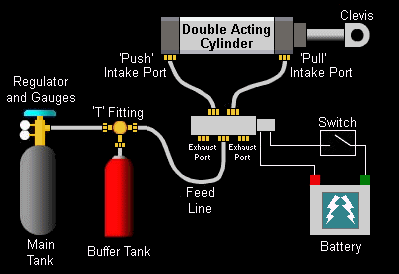 Let's start with the basic pneumatic system diagram from the Team DaVinci pneumatic tutorial:
Let's start with the basic pneumatic system diagram from the Team DaVinci pneumatic tutorial:
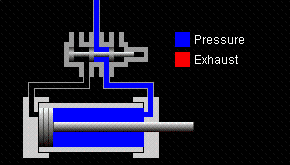 Two things happen simultaneously when a 5-port solenoid valve is powered:
Two things happen simultaneously when a 5-port solenoid valve is powered:
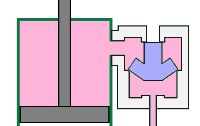 The Quick Exhaust Valve (QEV) is typically mounted right on the ram retract port. It passively allows gas to flow into the cylinder to retract the ram, but as soon as the gas pressure in the line from the solenoid valve drops below the pressure in the ram the QEV pops open a BIG port for the gas to rush out.
The Quick Exhaust Valve (QEV) is typically mounted right on the ram retract port. It passively allows gas to flow into the cylinder to retract the ram, but as soon as the gas pressure in the line from the solenoid valve drops below the pressure in the ram the QEV pops open a BIG port for the gas to rush out.
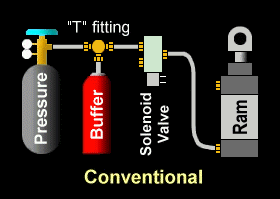 If the retract side of your ram is never pressurized, you don't need to worry about pulling pressure out of it. Many flipper styles will retract from gravity when the 'extend' side is vented, and many more will retract with a little assist from a spring or even a bungee cord.
If the retract side of your ram is never pressurized, you don't need to worry about pulling pressure out of it. Many flipper styles will retract from gravity when the 'extend' side is vented, and many more will retract with a little assist from a spring or even a bungee cord.
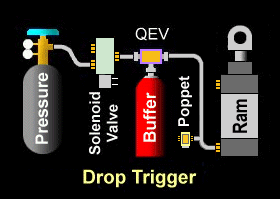 Paintball guns use a QEV to store a fixed volume of pressurized gas in a buffer tank and then release it to fire a paintball. This makes for economical use of the gas supply and a quick exit of gas from the buffer. This same method can be used to dump gas from a buffer tank into a pneumatic ram faster than a conventional solenoid valve.
Paintball guns use a QEV to store a fixed volume of pressurized gas in a buffer tank and then release it to fire a paintball. This makes for economical use of the gas supply and a quick exit of gas from the buffer. This same method can be used to dump gas from a buffer tank into a pneumatic ram faster than a conventional solenoid valve.
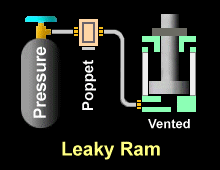 Commonly called a 'Full Pressure Insect Flipper', this is more like setting off a firecracker under a soup can than a real pneumatic system. A disposable CO2 cartridge attaches directly to a simple 2-port poppet valve that opens for just an instant and shoots a tiny squirt of high-pressure gas into a deliberately VERY leaky pneumatic ram. The gas blasts the flipper upward and quickly leaks out before pressure builds to explosive levels -- you hope.
Commonly called a 'Full Pressure Insect Flipper', this is more like setting off a firecracker under a soup can than a real pneumatic system. A disposable CO2 cartridge attaches directly to a simple 2-port poppet valve that opens for just an instant and shoots a tiny squirt of high-pressure gas into a deliberately VERY leaky pneumatic ram. The gas blasts the flipper upward and quickly leaks out before pressure builds to explosive levels -- you hope.
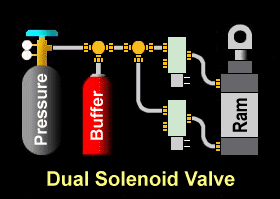 If your design does require a pressure-driven retract, there are several designs with multiple solenoid or poppet valves that allow each end of the ram to be independently pressureized and vented. Control of these systems is a bit more complex than a single-throw switch on your transmitter, but you gain maximum power and speed in both ram directions.
If your design does require a pressure-driven retract, there are several designs with multiple solenoid or poppet valves that allow each end of the ram to be independently pressureized and vented. Control of these systems is a bit more complex than a single-throw switch on your transmitter, but you gain maximum power and speed in both ram directions.
